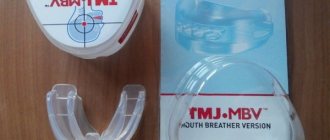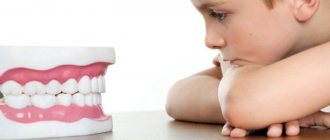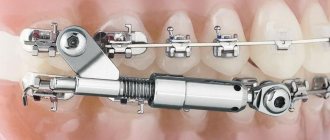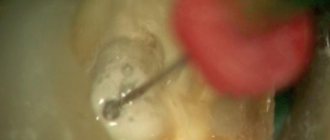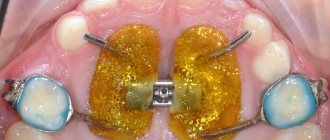3193
The pair of bones connecting the lower jaw to the base of the skull is the most important joint in the human body.
In cases of damage to the cartilage tissue of the articular surfaces, constant night attacks of teeth grinding or malocclusions, special TMJ dental trainers are used.
Indications for use
The dental device is a multifunctional device suitable for both adults and children from seven years of age.
At the very beginning of use, it does not require additional actions, such as taking impressions of the jaws, adjusting elements, or sharpening parts.
Wearing the TMJ myo-relaxing device is prescribed by an orthodontist in the following cases:
- Involuntary nocturnal grinding of teeth during sleep. The development of pathology can be caused by uncontrolled use of antipsychotic drugs, non-standard bite, epilepsy, stress and neuroses.
- Overstrain of mild structures , which led to tonic spasm of the masticatory muscles and limitation of muscle movements.
- Disorders of the act of swallowing resulting from inflammation of the oral cavity, foreign bodies, cicatricial narrowing and tumors.
- Unilateral, alternating throbbing pain in the forehead and temples.
- Disorders of the coordinated activity of the mandibular joint , which appeared due to: dynamic, statistical, central or functional occlusion.
- Fatigue with pain in the masticatory muscle.
- The occurrence of asymmetrical and insufficient breathing through the nose associated with any external injuries or displacement of the septum of the respiratory organ.
Severe trauma with swelling of the retrodiscal space
In cases of acute injury with swelling of the soft tissue behind the condyle, it is advisable to hold the articular head anteriorly to avoid compression of the affected retrodiscal space. Dr. Parker Mahan, former chairman of the University of Florida Facial Pain Center, even coined the phrase “Cheerleader Syndrome” to describe a clinic of cheerleaders who fell on their chins, causing them to develop joint pain, retroarticular swelling, and acute distal open bites. Examples of such symptoms are also “Airbag Syndrome”, “Barriff Syndrome” and “Extreme Gaming Syndrome”. In such cases, displacement of the articular head anteriorly for a period of 10-14 days is a diagnostic measure, as a result of which it is possible to achieve decompression of the already swollen and painful tissues. This treatment algorithm is also accompanied by an appropriate diet, taking anti-inflammatory drugs and physiotherapeutic procedures.
Design
The dental TMJ device is an arc-shaped element made of high-quality medical silicone, which is resilient and elastic.
It is characterized by increased resistance to chemical destruction and does not wear out, which guarantees its long service life.
The size of the trainer is selected individually. It should be remembered that the patient’s comfort will depend on the correct selection of the dimensions of the device.
On both sides of the device there are built-in special stabilizers for the tongue, which control its fixation, providing complete protection against biting.
Thanks to the wing-shaped side configuration, the dental device creates a pressure reduction, relaxing muscle tension. It is characterized by rapid adaptation to the individual characteristics of the jaws of any person, without causing allergies or discomfort when worn. It is selected by an orthodontist at the patient’s first appointment.
The design of the splint is thought out in such a way that when the device fits tightly to the dentition, it does not cause any inconvenience associated with articulation . Colorless medical grade silicone ensures discreet wearing.
In what cases is wearing the Biderman apparatus prescribed and the principle of its operation.
Come here to take a closer look at the design of the Muehlemann propulsor.
At this address https://orto-info.ru/sistemyi-vyiravnivaniya-zubov/individualno-izgotovlennyie-apparatyi/vo-vremennom-prikuse-haasa.html we will talk about the purpose of the Haas apparatus in orthodontics.
General information and purpose
The TMJ splint is a rigid, removable, thermo-modeling device that is worn like a mouthguard on one of the jaws.
The device is intended for intraoral use in adult patients. The design and construction were developed using a computer system. Supplied with preset parameters.
The splint is of great importance for doctors, as it allows them to begin correcting functional disorders already during the initial appointment.
Operating principle
Having started treatment with a splint, it is necessary to place it between the jaw bones to fully control their position and form the correct bite.
Due to the thickening in the structure at the point where the chewing teeth are located, there is a gradual decrease in pressure on the joint.
The soft, medical-grade polymer gently reduces stress by reducing enamel abrasion and reducing overall pressure on the muscles.
Thanks to the wing-shaped design and elastic material of the device:
- manifestations of arthrosis are reduced;
- symmetrical nasal breathing is normalized;
- Night teeth grinding is eliminated.
Long-term wearing of the splint neutralizes the pathologies described above , creating muscle decompression, relieving the patient of discomfort.
By following all the recommendations of the dentist or orthodontist, which consists of wearing a TMJ splint (about 1-1.5 hours during the day and fixing the device in the oral cavity all night), the patient will experience relief on the second day of use .
The first few days of using the trainer, you need to adapt to its presence in the oral cavity. Starting to wear the device for 15-20 minutes, gradually increase the wearing time.
If pain or loosening of teeth occurs, the duration of use should be reduced. If discomfort occurs at night, you should try to add hours to wearing the dental appliance during the day.
After using the silicone device for one to two months, the dentist determines the need for further treatment or wearing a retainer for preventive purposes.
The total duration of such therapy is about 2-7 months , depending on the disease. The correction and duration of the polymer device is determined only by an orthodontist. It is not recommended to refuse treatment on your own.
To improve the performance of the device, the dentist may prescribe:
- impulse therapy;
- inductotheralgia;
- hydrotherapy;
- franklinization;
- climatotherapy;
- ointments;
- tablet drugs.
Conclusion
Complete disc displacement (Piper stages IV-V) is a complex disorder in the joint structure that may be amenable to splint therapy (Fig. 16). Patients with a displaced disc in both the lateral and medial directions are considered chronically unstable and are likely candidates for surgical intervention. Acute types of lesions most often involve compression and overload of the densely innervated and vascularized retrodiscal space, while chronic lesions involve the possibility of ligament perforation, scar tissue formation, and bone-to-bone contact with the development of osteoarthritis.
Rice. 16. Complete disc displacement with load on the retrodisc space
Splint therapy allows you to stabilize the joint and provide conditions for its proper functional adaptation and remodeling. In stages IV-V according to Piper, the duration of splint therapy can be up to 3 months, and in the future the treatment period can be extended based on individual conditions.
If the joint cannot be fully positioned without discomfort, a rigid wax register must be obtained with the patient tilted slightly forward. If, with such a register, the patient is able to bite without discomfort, diagnostic models can be cast on it, which are positioned using a face bow. Splint correction is carried out over several weeks until the joint has fully adapted and is in proper position. If the affected joint can be positioned without discomfort in a sufficiently anterior position, it is necessary to make an anterior repositioning guide splint. Manufacturing is carried out in a similar manner to the preliminary preparation of a wax bite register. In such cases, the patient needs up to 2 weeks before he can again use a complete permissive splint or before he is referred for surgical treatment due to the ineffectiveness of splint therapy.
Care
The design of the TMJ trainer requires careful and meticulous care. Every day, after each use, the silicone device should be removed and rinsed under running water using a small brush and personal oral hygiene product.
You can replace toothpaste or powder with antiseptics:
- hydrogen peroxide;
- weak solution of potassium manganese;
- chlorhexidine;
- Furacilin.
To make it easier to wash off fatty particles from the tire, it is recommended to treat the device with baking soda . The trainer should be stored in a special container away from small children and pets.
Proper maintenance of the device will ensure the preservation of all its qualities and characteristics and will extend its service life.
If damage is detected on the TMJ splint in the form of scratches, punctures and tears, you should stop wearing it and consult an orthodontist.
It is worth knowing that with a mandatory visit to the dentist, on his recommendation, there may be a need for abrasive processing of the polymer device to give the desired bite.
Reasons for using the open Klammt activator and its device for the treatment of malocclusions.
In this article we will talk about the effectiveness of Bertoni screw plates.
Here https://orto-info.ru/sistemyi-vyiravnivaniya-zubov/lechebno-profilakticheskie-apparatyi/treynerami-infant.html you will find objective reviews about Infant trainers.
conclusions
It is essential that clinicians have a thorough understanding of all aspects of the dynamics of the masticatory system. Differential diagnosis by screening muscle function, joints and dental occlusion allows us to identify the main symptoms and signs of pathologies. Malocclusion and parafunction can be corrected through the use of splints described in this article. Joint pathologies can also be corrected using splints, however, given the etiology of their occurrence, this type of therapy is not always completely suitable for long-term stabilization of the TMJ.
Article published with permission from: AEGIS Communications
Translation: Miroslav Goncharuk-Khomin, Yulia Devyatko
Source: aegisdentalnetwork.com
Recommendations for use
- After placing the silicone element in the oral cavity, make sure that the tongue stabilizer is always in the upper part.
- Gradually closing your jaw, you should touch the surface of the splint with your teeth.
- Keep your mouth closed, trying to inhale only through your nose.
- Under no circumstances should you squeeze the device too tightly or try to chew it!
- If discomfort occurs due to the large size of the silicone element, you can cut off its ends.
- To prevent swelling, massage your gums with your finger 1-2 times a day.
Chronic painful disorders associated with disc displacement
If anterior displacement of the disc causes compression of the retrodiscal space, it is logical that displacement of the condyle to a more anterior position can only have a positive effect. If it is possible to achieve complete reduction of the disc in the anterior joint position using a guide splint and the proper position cannot be achieved using a permissive splint, the choice between these designs is clear. The challenge is to ensure long-term stability of the required disc position. But in general it seems impossible to achieve a healthy anterior position of the disc and head and then carefully move it to the desired superior position in the fossa. In addition, fibrous contractures of the lateral pterygoid muscle, unstable formation of soft tissues in the joint structure and destabilized bite remain a problem.
Expected effect
Important! Symptoms of TMJ dysfunction with timely treatment with the TMJ splint decrease or disappear completely without the use of additional procedures.
This device already helps in the first days of wearing:
- reduce acute pain and other symptoms;
- relieve the load from the joint;
- limit bruxism;
- eliminate parafunctional habits (for example, tongue swallowing);
- correct occlusion;
- eliminate reverse swallowing;
- cure mouth breathing;
- reduce the load on the dentition during athletic sports.
In addition to the therapeutic effect, the joint splint allows you to diagnose conditions that cause pain in the head and neck.
Reviews
Modification of the TMJ joint splint quickly corrects many temporal joint dysfunctions. The combination of unique design, treatment effectiveness, and affordable cost makes its use in demand.
You can talk about your experience in eliminating joint problems using this device or express your opinion regarding the effectiveness and rationality of using the splint by leaving a comment on this article.
If you find an error, please select a piece of text and press Ctrl+Enter.
Tags bite trainers
Did you like the article? stay tuned
Previous article
Restoration of pulpless teeth using Unimetric pins
Next article
Optragate in dentistry – easy for the specialist and comfortable for the patient
